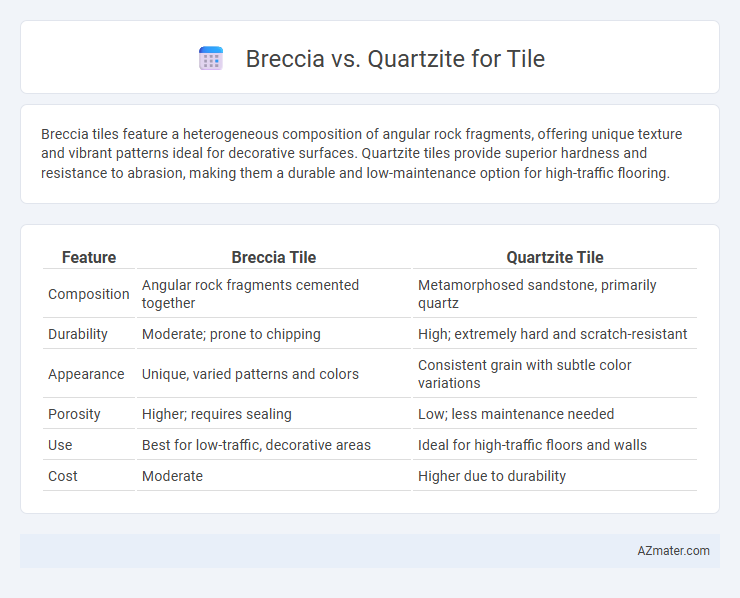Breccia tiles feature a heterogeneous composition of angular rock fragments, offering unique texture and vibrant patterns ideal for decorative surfaces. Quartzite tiles provide superior hardness and resistance to abrasion, making them a durable and low-maintenance option for high-traffic flooring.
Table of Comparison
| Feature | Breccia Tile | Quartzite Tile |
|---|---|---|
| Composition | Angular rock fragments cemented together | Metamorphosed sandstone, primarily quartz |
| Durability | Moderate; prone to chipping | High; extremely hard and scratch-resistant |
| Appearance | Unique, varied patterns and colors | Consistent grain with subtle color variations |
| Porosity | Higher; requires sealing | Low; less maintenance needed |
| Use | Best for low-traffic, decorative areas | Ideal for high-traffic floors and walls |
| Cost | Moderate | Higher due to durability |
Introduction to Breccia and Quartzite Tiles
Breccia tiles feature a distinctive appearance with angular, fragmented mineral patterns cemented together, offering a bold and textured aesthetic ideal for decorative flooring and wall applications. Quartzite tiles, formed from metamorphosed sandstone, are known for their exceptional hardness, durability, and natural quartz-rich composition that provides a smooth, often glassy surface suited for high-traffic areas. Both breccia and quartzite tiles represent premium natural stone options; breccia emphasizes dramatic visual impact, while quartzite delivers superior strength and wear resistance.
Geological Origins: Breccia vs Quartzite
Breccia forms from angular rock fragments cemented together by mineral matrices, originating through sedimentary or tectonic processes that create a chaotic, clastic texture. Quartzite develops from the metamorphism of pure quartz sandstone under intense heat and pressure, resulting in a dense, interlocking crystalline structure. The geological contrast between breccia's fragmented composition and quartzite's recrystallized quartz impacts their durability and aesthetic in tile applications.
Visual Characteristics and Appearance
Breccia tiles feature a unique composition of angular fragments in varied colors, creating a bold, mosaic-like appearance with high visual contrast and natural texture. Quartzite tiles showcase a more uniform, crystalline structure with subtle veining and a smooth, glossy finish, offering a refined and elegant look. The choice between Breccia and Quartzite tiles depends on the desired aesthetic impact, whether emphasizing dynamic patterns or understated sophistication.
Durability and Strength Comparison
Breccia tiles exhibit strong durability with their unique composition of angular fragments bound by a mineral cement, offering high resistance to impact and wear. Quartzite tiles surpass Breccia in overall strength due to their metamorphic origin and tightly interlocked quartz grains, providing exceptional hardness and scratch resistance. When selecting tiles, quartzite is preferable for high-traffic areas demanding superior strength, while Breccia offers aesthetic appeal with respectable durability for moderate use.
Tile Suitability for Indoor and Outdoor Use
Breccia tiles offer a striking, multicolored appearance with natural veining, making them ideal for indoor decorative applications such as flooring, walls, and feature areas where aesthetic impact is desired. Quartzite tiles provide exceptional hardness and durability, with resistance to scratching and weathering, making them highly suitable for both indoor flooring and outdoor use in patios, walkways, and pool surrounds. While breccia may require sealing and is more prone to etching and wear outdoors, quartzite's dense, non-porous surface ensures long-lasting performance in harsh environmental conditions.
Maintenance and Cleaning Requirements
Breccia tiles require regular sealing to prevent staining and moisture penetration due to their porous nature, making maintenance more intensive compared to quartzite. Quartzite tiles are denser and more resistant to scratches and stains, necessitating less frequent sealing and easier cleaning with mild detergents. Both materials benefit from prompt spill cleanup, but quartzite's durability ensures lower overall maintenance efforts in high-traffic or moisture-prone areas.
Cost Differences: Breccia vs Quartzite
Breccia tiles generally cost less than quartzite tiles due to their relative abundance and simpler quarrying process. Quartzite's higher price reflects its superior hardness, durability, and more complex extraction methods. Choosing between breccia and quartzite tiles depends on budget constraints and long-term performance needs.
Popular Applications in Design
Breccia and quartzite are favored in tile design for their durability and unique visual appeal, with breccia offering bold, fragmented patterns ideal for statement walls and flooring in luxury interiors. Quartzite's dense, crystalline structure makes it perfect for high-traffic areas such as kitchen countertops and bathroom vanities, where both aesthetics and resilience are essential. Both materials are popular in modern and rustic design schemes, enhancing spaces with natural stone's elegance and varied texture.
Environmental Impact and Sustainability
Breccia and quartzite tiles differ significantly in environmental impact and sustainability; quartzite is a natural metamorphic stone sourced with minimal chemical processing, resulting in lower emissions and better durability that extends tile lifespan, reducing the need for frequent replacement. Breccia, composed of fragmented rock cemented together, often requires more intensive quarrying and processing, which can lead to greater environmental disturbance and higher energy consumption. Opting for locally sourced quartzite tiles enhances sustainability by minimizing transportation emissions and promoting responsible mining practices aligned with eco-friendly certifications.
Choosing the Right Tile for Your Project
Breccia and quartzite offer distinct characteristics for tile applications, with breccia featuring a unique, fragmented pattern ideal for statement floors and walls, while quartzite provides superior hardness and resistance to scratches, making it suitable for high-traffic areas. Consider the project's requirements: breccia's porosity demands more sealing and maintenance, whereas quartzite's durability supports longevity and minimal upkeep. Selecting the right tile involves balancing aesthetic preference with functional needs, ensuring the material complements the intended use and environment of the space.

Infographic: Breccia vs Quartzite for Tile
 azmater.com
azmater.com